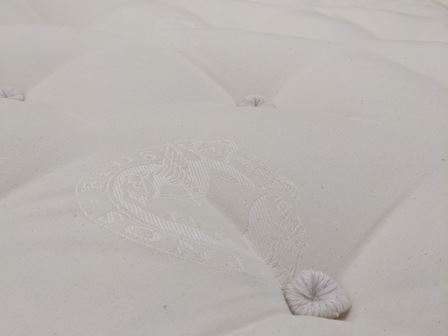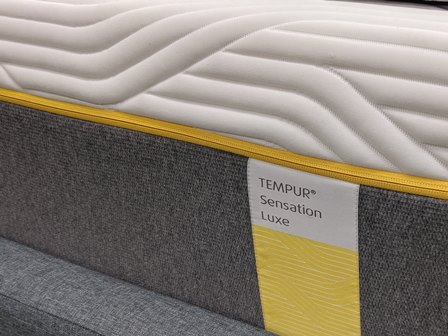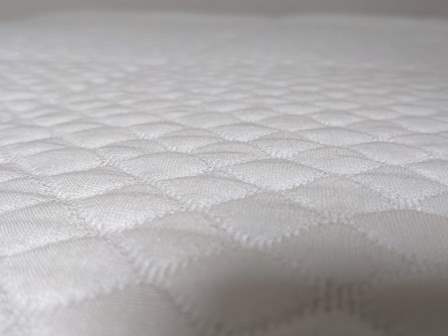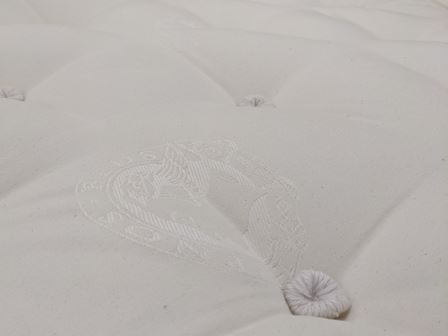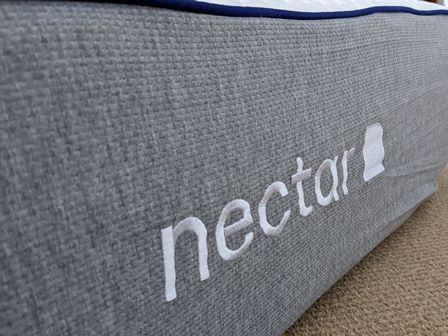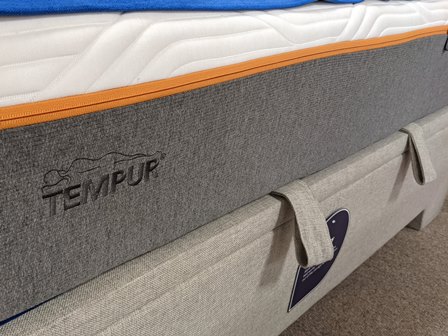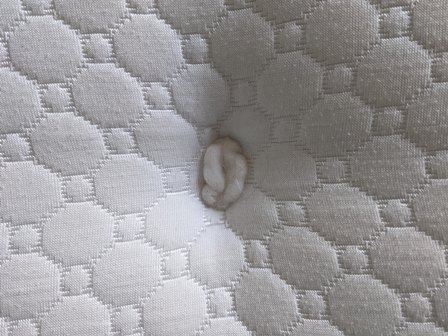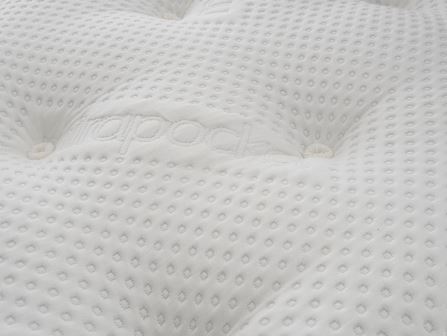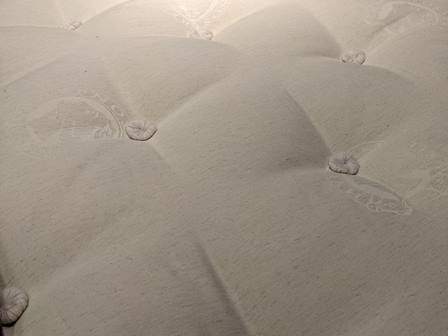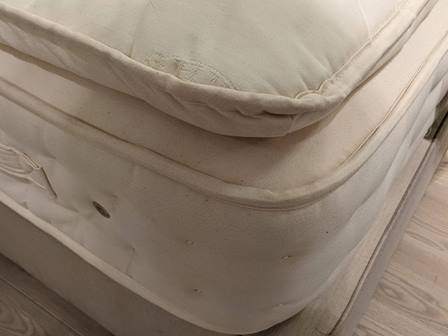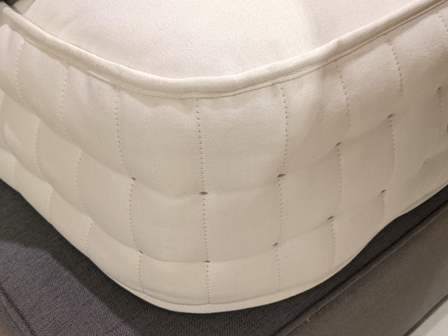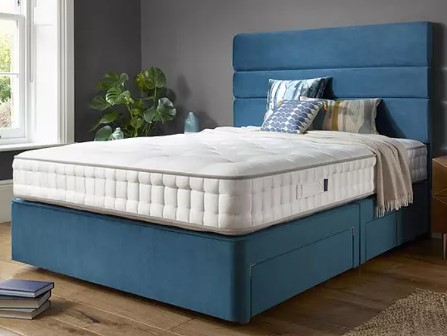Memory foam or spring mattress is probably the biggest debate in the thrilling world of online mattress discussions.
It’s hard to know who to believe because most of the arguments are made by manufacturers. I don’t work for either.
After reading dozens of articles (yawn…) my 8 conclusions are:
1. More people buy pocket spring mattresses than memory foam
Popularity is certainly not everything. However, it is the case that more people buy pocket spring mattresses than memory foam mattresses.
About two thirds of mattresses sold around the world are either pocket sprung or ‘coil’ according to Fortune Business Insights. Coil mattresses are the cheaper alternative (2019 data). IbisWorld research suggests sprung mattresses are also still number one in the UK.
Vispring developed pocket springs more than 100 years ago. They remain one of the best brands of luxury pocket spring mattresses.
Other pocket spring brands in our 6 best pocket spring mattresses guide include:
- Hypnos and mid-priced Sleepeezee which both supply beds to the Royal Family.
- Harrison Spinks which make the John Lewis Natural Collection. They are one of the few mattress brands with a Manufacturing Guild Mark.
- Silentnight are a popular and mid-priced brand with several award winning models.
Memory foam was developed by NASA to help astronauts stay nice and cosy inside their rockets. The technology was later developed into a mattress, with one of the earliest pioneers being Tempur. They are which is still one of the biggest brands in the market.
Other (cheaper) memory foam mattresses in our top 6 memory foam mattresses guide include:
Nectar Sleep Mattress (£600)
The Nectar Sleep mattress stands out from the intense competition by offering a 365-night trial period. If you don’t like it within the first year of ownership, they’ll collect it and give you a refund. On top of that, it has a ‘forever’ guarantee. That means they’ll provide ongoing support (see terms and conditions obviously).
[affcoups id=”3062″]
Silentnight 3 Zone Memory Foam mattress (£454)
The 3 Zone from Silentnight is at the budget end of the memory foam mattress market. For a couple of hundred pounds you get an award winning double mattress from a brand you’ve heard of. The main downside is that it is a lot thinner than more expensive mattresses. The actual layer of memory foam is only 3cm deep, whilst the overall depth is 18cm. By contrast, the Nectar Sleep is 25cm deep including a 9cm layer of memory foam.
[affcoups id=”3318″]
Loads of mattresses nowadays also offer a mix of pocket springs and memory foam. The springs are on the bottom with a ‘comfort’ topper of memory foam on top. These are usually called ‘hybrid mattresses’. See our guide to the best hybrid mattresses if that’s what you’re after.
2. Memory foam (supposedly) lasts a bit longer than pocket springs
The general consensus online (once I’d ignored all the biased arguments) was that memory foam should last a bit longer than a pocket spring mattress. I’ve not found a conclusive scientific study into this.
In theory, memory foam returns to its normal shape time and time again, whereas pocket spring mattresses start to get a bit stuck in their own grooves. Turning pocket sprung mattresses over regularly helps. Unfortunately, lots of modern mattresses can’t actually be turned over. In some cases this is because they have a topper on one side. In other cases it is because the manufacturer has put the high quality materials towards the top of the mattress to save some money.
Honestly, I think you could argue about durability until the cows come home. From what I’ve read, it seems likely that a high quality pocket sprung mattress which was turned over regularly would outlast a cheap memory foam mattress. Similarly, a high quality memory foam mattress would outlast a cheap pocket spring mattress.
It’s certainly true that there are lots of memory foam mattresses with 10 or 15 year warranties (e.g. REM Fit, Simba Sleep, Emma Mattress, Eve Sleep). Most pocket sprung mattresses come with 5-10 year warranties. The Nectar Sleep Memory Foam Mattress goes so far as to offer a ‘forever’ warranty (check the Ts and Cs, of course).
3. Memory foam can make you feel hot
Heat is probably the complaint that comes up most often in the numerous memory foam reviews and discussions I’ve read. You won’t really get that with a pocket spring mattress (unless it’s one with a memory foam layer on top obviously).
Also, memory foam mattresses will get a little bit firmer if your room gets really cold and a bit softer if your room gets hot.
There are fancy new attempts to keep memory foam cool, such as ‘gel memory foam’. Similarly, a lot of modern ‘bed in a box’ mattresses put the layer of memory foam lower down the mattress. The idea is that you get the support of memory foam but with a cooler layer on top. Many of these mattresses get very positive reviews on TrustPilot and have won awards (some feature in our top 10 mattress guide).
Don’t like it? Send it back
Most of these mattresses offer a free trial so if you don’t like it, they’ll take it back. If you can afford it, and want a more traditional memory foam mattress then perhaps try something like a Tempur mattress which offers a 100 night guarantee. Alternatively, you get a trial of between 30 nights and 200 nights with the Eve Sleep (£649), Emma Mattress (£299), Ergoflex (£966) and several others. Mattress company Nectar Sleep (£600) gives 365 night trials which is the joint longest we know of in the UK market alongside DreamCloud Sleep (£1649).
You don’t get as many pocket spring mattresses which offer a trial period although respected brand Sleepeezee offer a 60 night sleep trial which offers a swap if you’re not happy and Soak & Sleep give you 100 nights to try out a mattress if you use a mattress protector. Obviously it’s important to read the terms and conditions before taking out a trial period.
A 2018 study by Chiba, Yabi et al digs a little deeper into the science of choosing a memory foam or spring mattress. They compared rectal body temperature of people whilst they slept on ‘high rebound mattress toppers’ and ‘low rebound mattress toppers’ (i.e. memory foam). Those sleeping on the ‘low rebound’ topper were up to half a degree warmer (celsius) during the night.
4. Memory foam mattresses are lighter
Memory foam mattresses are a bit lighter. That makes them better for transporting or if you have trouble flipping a pocket spring bed. It’s also better if you’ve got a slatted bed which can’t take much weight.
It seems to be a more noticeable difference at the cheaper end of the mattress market though.
For example, I looked at two high quality mattresses and they were pretty similar. A 21cm deep King Size Vispring pocket spring mattress on John Lewis weighs 52kg whilst a 21cm Tempur Memory Foam mattress weighs 48kg.
5. Memory foam feels a bit strange
The next chapter in the memory foam or spring mattress debate might sound a little nutty.
Some people find that memory foam feels like they are sinking into quicksand, which is a bit unnerving.
Pocket springs don’t tend to give that sinking feeling. It’s also easier to toss and turn in the night with a pocket spring mattress. So, if you’re a fidget Bridget then you might find memory foam hard work.
What the science says about sleeping on a memory foam or spring mattress
Some research has been carried out into whether you sleep better on a memory foam mattress or a sprung mattress. One study worth discussing was called ‘Comparative Effects of Sleep on a Standard Mattress to an Experimental Foam Surface on Sleep Architecture and CAP Rates’ which was published in 1997 by Scharf, Stover et al. The study refers to ‘innerspring’ mattresses, which is the name for a sprung mattress in the USA.
The study explored the ‘CAP rate’ which is the cyclic alternating pattern and relates to patterns of how we sleep. In summary, poor sleep is often associated ‘with elevated CAP rates’.
Researchers enlisted 10 participants and got them to spend several nights of an ‘experimental foam surface’ and on a ‘high quality innerspring hospital mattress’.
The study found ‘no differences in sleep stages, number of wakes, or total sleep time between the two conditions.’ However, they did find that ‘CAP rates were significantly reduced on the foam surface’. That should be seen as a victory for the foam mattress in the memory foam or spring mattress argument.
What the scientists say about mattress firmness
Another study worth mentioning is that carried out in China and published in 2009 by Wang, Zhou et al called ‘Quality of sleep, as influenced by mattresses with various degree of firmness‘. The study compared mattresses including a soft ‘sponge mattress’, a medium firmness ‘innerspring mattress’ (i.e. a sprung mattress) and a firm ‘wooden board mattress’.
30 people took part and tested each mattress for one night. They were then asked to give their opinion of how well they had slept (‘each subject accepted sleep quality evaluation with Sleep Quality Questionnaire and Self-feeling Scale of Sleep’).
On every area, the medium firmness sprung mattress was the winner. Participants gave higher scores to the sprung mattress on the ‘Sleep Quality Questionnaire’ and the ‘Self-feeling Scale of Sleep’. They also found that ‘The amount of body movement of the subjects were less when using innerspring mattress’ and that the body was better supported (‘The pressure and support of the buttocks,scapular and low back of the subjects to the mattress showed more desirable when using innerspring mattress than those when using board mattress or sponge mattress‘).
Finally, they found that the position you sleep in didn’t affect the result (‘No matter lying on the back or on the side,the body mattress interface area on the innerspring mattress showed more acceptable‘).
I have mixed feelings about this particular piece of research. It tells us more about how people responded to soft, medium and firm mattresses than it does about memory foam v pocket springs. However, it was a study which put both mattress types side by side in a controlled academic environment. It’s still worth a mention for that reason.
6. Memory foam is supportive and good for joint pain
People used to think that a really firm bed was the answer if you have back pain.
From what I’ve read, that theory doesn’t hold water any more. Nowadays, people just advise that ‘a supportive and comfortable mattress is the best option – it doesn’t matter what type of construction it is’ (that’s according to the Sleep Council).
According to the Sleep Council ‘When you lie on your side your spine should be horizontal’ which is something that good quality Memory Foam is generally very good at.
A good quality pocket spring mattress can certainly offer decent support. However, I’ve read lots of articles saying that memory foam is particularly good for joint pain. For example, the charity Versus Arthritis says ‘many people find memory foam mattresses or toppers helpful’. That advice is specific to arthritis, of course.
See our guide to mattresses for bad backs.
Your age and sleeping position is important
On a related note, a study in China was carried out in 2020 to see how well people responded to different types of mattress. It was based on their age and their sleeping position. It was carried out by Hou and Zhang and was called ‘The Influence of Mattress Material on Sleeping Comfort of Different Age’.
A notable conclusion was that younger age groups had a positive response to memory foam and latex mattresses whether they slept on their back or side (‘The young and middle-aged subjects had high evaluation on memory foam, and latex mattress in supine and lateral position‘).
Slightly older participants ‘had higher evaluation on memory foam, and coir mattress’ in both back sleeping and side sleeping positions. Meanwhile, ‘elder subjects preferred coir and cotton mattress’ when sleeping on their back and ‘preferred memory foam and coir mattress’ when sleeping on their side.
Spreading your weight out and relieving pressure points is another area where memory foam tends to perform well. In one study, researchers Gunningberg, Lindholm et al gave visco elastic foam mattresses to patients in hospital. A visco elastic mattress is another name for a memory foam mattress.
They found that ‘patients on standard mattresses tended to develop more severe pressure ulcers’ than those on the memory foam mattresses. See ‘Effect of visco-elastic foam mattresses on the development of pressure ulcers in patients with hip fractures’, published in 2013.
7. Memory foam is less natural than pocket springs and ‘has a higher environmental impact’
The question of whether a particular mattress is ‘green’ or ‘sustainable’ or ‘environmentally friendly’ is open to debate. Inevitably, there are multiple ways to measure such things.
Is it more important what a mattress is made from or whether it can be recycled? Or is it more important that it is made locally rather than being transported across the world?
An academic study worth mentioning is one called ‘How do end of life scenarios influence the environmental impact of product supply chains? Comparing biomaterial and petrochemical products’ (Glew, Stringer et al 2012). The study found that a pocket sprung mattress which uses natural fibres (e.g. wool, cotton, coir, latex) will ’emit marginally less greenhouse gasses’ than a pocket sprung mattress which uses foam.
Lots of websites make it very hard to find out what materials their pocket spring mattresses are made from. One of the clearest bed sellers I’ve found is John Lewis & Partners. It doesn’t list percentages, but it does list fabrics.
What happens once you’ve finished with your mattress?
Glew, Stringer et al also said that the difference between foam and natural materials once ‘end of life scenarios’ were considered was more significant. By which they mean that the environmental impact of disposing of an old mattress is a big victory for natural fibres over foam (‘Refurbishing natural fibre mattresses and reusing the springs, coupled with recycling the waste components, can reduce greenhouse gas emissions by 90% compared to sending the mattresses to landfill’.)
Another study into the environmental impact of mattresses by Lanoë, Simões et al (2013) compared foam mattresses with pocket sprung mattresses. They looked at environmental impact over the product’s life and found that the foam mattress ‘has a higher environmental impact’ than the pocket sprung mattress with the main cause being ‘the foam block moulding process for the’ foam mattress.
In the interests of balance, it’s worth saying that some memory foam brands offer quite a lot of detail when it comes to sustainability. For example, Nectar Sleep’s sustainability page says that ‘our mattress production is certifiably climate neutral’ which involves a policy ‘to calculate the carbon footprint from our manufacturing process, find strategies to reduce this, and offset the remainder.’
The ongoing debate about dust mites on a memory foam or spring mattress
On the issue of allergies to dust mites, there is mixed information and research. According to Mattress Online ‘Foam mattresses are particularly beneficial in lowering the risk of dust mites and allergens in your bedroom’. The reason for this is that ‘The solid core structure of these mattresses makes them impenetrable to dust mites’. Other guides offer similar advice.
However, a study in Norway by Schei, Hessen and Lund appears to offer contrary advice (‘House-dust mites and mattresses’ 2002). They took samples from foam and sprung mattresses and found ‘the risk of finding mite feces was four times higher in foam compared to spring mattresses…and eight times higher for the foam mattresses without cover’. Their conclusion was that ‘a simple replacement of foam mattresses with spring mattresses may reduce the exposure to house-dust-mite allergens’.
A separate study by Zock, Heinrich et al in 2006 found that ‘Important risk factors for high allergen levels included an older mattress, a lower floor level of the bedroom, limited ventilation of the bedroom, and dampness’
Lots of reports say that cheap memory foam smells bad when it is new and it can be a bit ‘artificial’ smelling. This is because it is made from polyurethane (a form of plastic) rather than ‘natural’ materials. This is sometimes called off-gassing.
Is a memory foam or spring mattress better for your health?
There’s another factor which you might want to dismiss or worry about, depending on your approach to life. This article by WebMD suggests your body heat whilst sleeping may ‘trigger the release of potentially harmful chemicals from your mattress’. It suggests that it’s more of an issue with foam mattresses. They said: ‘These Volatile Organic Compounds come mainly from the polyurethane used in the mattress, but also from other chemicals used in flame retardants and plastics’.
It later says that it’s less of an issue in the natural materials which you tend to find in expensive pocket sprung mattresses (‘Mattresses containing cotton, wool and natural latex will all produce lower levels of gases‘). However, it also says that ‘The estimated doses of most VOCs remained well below the levels that could cause health effects’. However, ‘some compounds did reach levels of concern for infants and young children’.
8. Pocket springs and memory foam are good for covering up ‘rebound’
I wasn’t sure quite what rebound was either. It sounded like it was something to do with breaking wind.
It actually means feeling when someone else in the bed is moving. Cheaper open coil spring mattresses aren’t so good for this, but a decent pocket spring or memory foam mattress seem to be similarly rated in this category.
If you want further reading on this, have a look at ‘The Evaluation of Compatibility between Human and Mattress using EMG’ by Park, Subramaniyam et al (2014). They compared a sprung mattress with a Tempur foam mattress and found that the ‘Spring mattress provided significantly greater relaxation’. On top of that, there was ‘significantly lower muscle activities when the subject tossed and turned to their right on the spring mattress than (the) Tempur mattress’.
Highly-rated memory foam mattresses
Memory foam mattresses featured in our guide to 6 of the best memory foam mattresses, include:
Budget memory foam mattresses:
Silentnight 3 Zone Memory Foam mattress (£202 for a double) –
This mattress is certainly at the budget end of the scale, but it will do the job for some people. You’re getting a mattress by a brand you’ve heard of for a couple of hundred pounds. However, it’s worth noting that it is only 18cm deep and the memory foam layer makes up just 3cm of that. Most high quality mattresses are 20-30cm deep. It’s also soft/medium, so it’s more likely to be suited to someone who is lighter than average who might not feel the benefit of a deeper mattress. Customer reviews are solid (though not spectacular) and it has won a big award.
[affcoups id=”3318″]
Anyday by John Lewis Memory Foam mattress (£239)
The appealing thing about this mattress is the John Lewis & Partners brand, but let’s acknowledge there are some shortfalls. Most notably, it is only 15cm deep only 2cm of that is memory foam. However, some trundle beds and bunk beds only have space for a shallow mattress, so this will fit the bill for some people. Customer reviews are good (4.3/5) and, of course, it is sold by a trusted retailer. The seven year warranty is also much longer than I would usually expect with a budget mattress.
[affcoups id=”3320″]
Mid-priced memory foam mattresses:
Nectar Sleep Mattress (£600)
This medium/firm mattress first got our attention because it was offering a colossal 365 night trial. On top of that is the ‘forever’ guarantee which was unheard of in the mattress industry. There are terms and conditions but you’re getting a mattress with a good specification for a very reasonable price.
Overall, it is 25cm deep which is 7-10cm more than some budget models. It’s won awards from experts and was scoring 4.3/5 from customers on TrustPilot at the time of writing in 2024. The company also manufactures mattresses in a carbon neutral way.
[affcoups id=”3062″]
Ergoflex 5G Mattress (£966)
The Ergoflex 5G provides stiff competition to the Nectar Sleep mattress above. They are both rated as medium/firm mattresses and have a similar overall depth. However, Ergoflex has been selling mattresses for a lot longer than most ‘bed in a box’ brands. They proudly boast that they’ve been trading longer than the 10-year warranty which they offer. Many mattress companies can’t claim this. Much like the Nectar Sleep you get a trial period, so you can try it out at home. However, it’s only a 30 night trial so you can’t try it out in all seasons before making your mind up. It’s a very highly rated brand on TrustPilot with average of 4.8/5 when we checked.
[affcoups id=”3120″]
Luxury memory foam mattress:
Tempur Original Supreme (£1749)
Yes, you’re paying three or four times as much but Tempur are the original and the poshest of the memory foam brands. Tempur used NASA technology to develop the first memory foam mattresses. This model is medium/firm but they have softer and firmer models in the range. You can also choose from three different depths, with the thinner model costing less than the deeper model. As with many memory foam mattress brands, you can try it with a 100-night trial period. The brand scores 3.8/5 on TrustPilot as of 2024.
[affcoups id=”3323″]
Highly-rated pocket sprung mattresses
Pocket spring mattresses featured in our guide to 10 of the best mattresses include:
Budget pocket sprung mattresses:
Happy Beds Majestic 1000 (£249)
Happy Beds don’t have the history or brand recognition of Silentnight or Vispring. Then again, they don’t have the same price tags. This medium tension pocket spring mattress has a good specification and reviews considering the modest cost. The price is similar to one of those nasty open coil mattresses you had to sleep on at your grandma’s house. It has enough springs for a light person, but you’ll want more support if you’re heavier than average. We also like that you can turn this mattress over, which should help it last a little longer. The five year warranty is good for the price.
[affcoups id=”3270″]
Happy Beds Signature Platinum 2000 (£259)
Spend a little more and you can upgrade to a Happy Beds mattress which has a higher number of springs. It is also a little bit firmer and is graded as medium/firm tension. It’s a similar bed to the Majestic 1000 has double the number of pocket springs, so offers more support for heavier people.
As with the 1000 model, you can turn it over which is a good feature for avoiding dips and bumps in a mattress over the months and years. You’ll find it isn’t a feature that you get in mattresses with a ‘pillowtop’ layer or with most foam mattresses.
[affcoups id=”3325″]
Mid-priced pocket sprung mattresses:
Silentnight Sofia 1200 Mirapocket Mattress (£449)
This mattress from Silentnight is medium/firm tension, much like the Happy Beds Signature Platinum 2000 model. For the extra money you’re buying from the biggest name in mattresses in the UK. It’s also an award winner and has customer scores of 4.7/5 at the time of writing (2024). The 1200 refers to the number of springs, which is plenty unless you are very heavy. It’s a simple and effective design which enables you to turn it over. That means it will last longer, although it’s bad news if you have a bad back and can’t lift it.
[affcoups id=”3327″]
Silentnight Deluxe Box Top Mirapocket 2000 Limited Edition Mattress (£629)
At the softer end of the firmness scale is this popular mattress from Silentnight. It’s usually graded as soft/medium.
It is made by the biggest mattress sleep brand in the UK (according to my research). Customer ratings are 4.4/5 from 100+ reviews which isn’t to be sneezed at. You can’t turn this one over as it has an 8cm deep layer of ‘super soft foam’ on top of two layers of springs.
Another plus point is the 60 day comfort trial, which means you can swap it if it’s not comfortable. There are some terms and conditions to read first.
[affcoups id=”6220″]
Luxury pocket sprung mattresses:
DreamCloud Sleep Mattress (£1649)
This mattress is made by the same company as the Nectar Sleep mattress mentioned earlier. It’s the only other mattress we know of on the UK market which offers a 365 night home trial period and a ‘forever’ guarantee. The trial period means that you can return it for a refund if you find that it’s not right for you after several months of use.
Much like the Nectar Sleep, it is medium/firm. However, the DreamCloud sleep is technically a hybrid mattress as the pocket springs are covered with two layers of foam for comfort.
[affcoups id=”3329″]
Hypnos Luxury Wool No. 1 Mattress (£1149)
Hypnos has a lot of kudos thanks to years to manufacturing high quality mattresses in the UK. They supply the Queen’s household and they also supply some big hotel chains, such as Premier Inn. This is one of the cheaper mattresses in their range, but it’s still well constructed with natural materials and pocket springs. It isn’t as luxurious in its specification as some Hypnos mattresses, but customers give it very good reviews. It is a medium/firm mattress although they do sell a similar model called the Luxury Wool No. 2 which is medium tension.
[affcoups id=”3312″]
Vispring Plymouth Supreme (£1429)
Much like Hypnos, Vispring has established a reputation for quality mattresses over many years. In Vispring’s case, their credibility stems from their role in the invention of the pocket spring mattress, which eventually became the norm. Again, it’s one of their cheaper models – you can easily spend several thousand pounds on a Vispring mattress. However, it has many of the Vispring’s usual signs of quality and gets very good reviews. If you spend a higher amount then you will get a higher spring count and a more complicated design with multiple layers of natural materials. This model is medium tension.
[affcoups id=”3302″]
John Lewis & Partners Natural Collection Egyptian Cotton 5750 Pocket Spring Mattress (£1199)
Don’t get too excited about the 5750 springs, most of them are tiny because you can only squeeze about 2000 full size springs onto a single layer on a pocket sprung mattress. Instead, it uses a combination of full-size springs and mini springs to achieve comfort and support. Reviews are good and it’s made by a company called Harrison Spinks which was named best manufacturer at the National Bed Federation awards in 2014 and 2018. For some reason the BBC don’t televise those awards… This mattress is medium tension.
[affcoups id=”3277″]
Quite a few mattresses have a bit of both – they have pocket springs, but they also use memory foam. These are usually called hybrid mattresses.
Personally, I tend to buy pocket sprung mattresses just because I don’t like the sinking feel of memory foam and am prone to feeling too hot in bed, but there are clearly loads of good arguments for memory foam. I also like some of the ‘bed in a box’ mattresses which are made of foam, but don’t sink in quite the same way.
